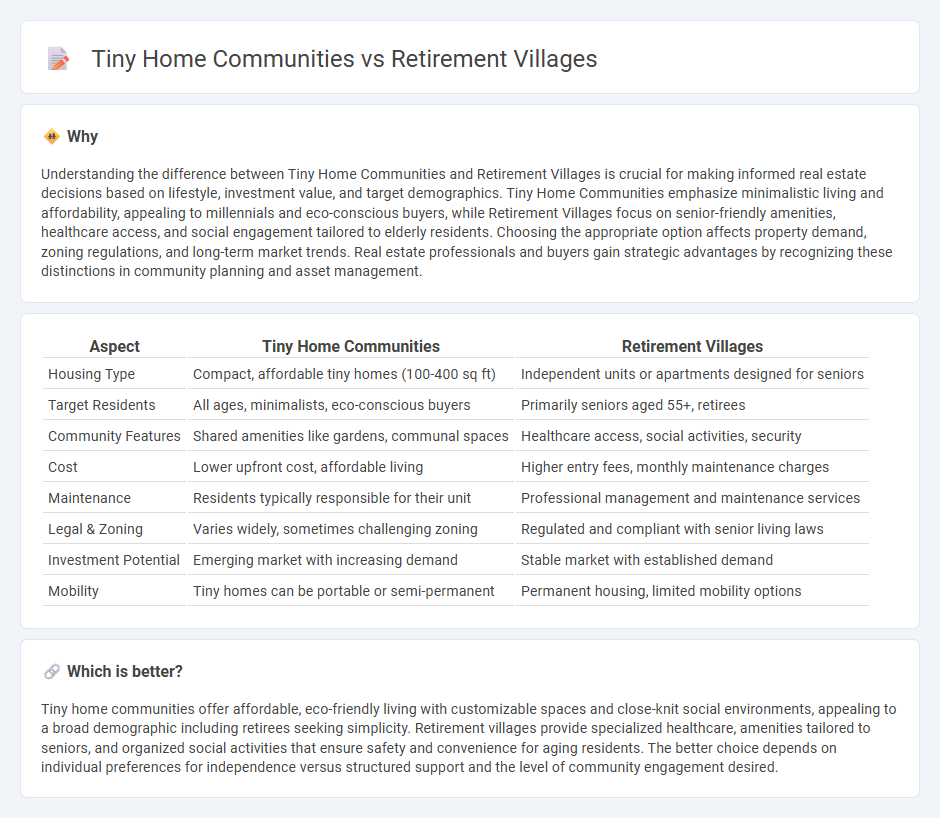
Tiny home communities offer affordable, minimalist living with a strong focus on sustainability and community engagement, attracting younger and environmentally-conscious residents. Retirement villages provide specialized amenities, healthcare options, and social activities tailored specifically for seniors seeking comfort and security in their later years. Explore the benefits and differences between these housing options to find the best fit for your lifestyle and needs.
Why it is important
Understanding the difference between Tiny Home Communities and Retirement Villages is crucial for making informed real estate decisions based on lifestyle, investment value, and target demographics. Tiny Home Communities emphasize minimalistic living and affordability, appealing to millennials and eco-conscious buyers, while Retirement Villages focus on senior-friendly amenities, healthcare access, and social engagement tailored to elderly residents. Choosing the appropriate option affects property demand, zoning regulations, and long-term market trends. Real estate professionals and buyers gain strategic advantages by recognizing these distinctions in community planning and asset management.
Comparison Table
| Aspect | Tiny Home Communities | Retirement Villages |
|---|---|---|
| Housing Type | Compact, affordable tiny homes (100-400 sq ft) | Independent units or apartments designed for seniors |
| Target Residents | All ages, minimalists, eco-conscious buyers | Primarily seniors aged 55+, retirees |
| Community Features | Shared amenities like gardens, communal spaces | Healthcare access, social activities, security |
| Cost | Lower upfront cost, affordable living | Higher entry fees, monthly maintenance charges |
| Maintenance | Residents typically responsible for their unit | Professional management and maintenance services |
| Legal & Zoning | Varies widely, sometimes challenging zoning | Regulated and compliant with senior living laws |
| Investment Potential | Emerging market with increasing demand | Stable market with established demand |
| Mobility | Tiny homes can be portable or semi-permanent | Permanent housing, limited mobility options |
Which is better?
Tiny home communities offer affordable, eco-friendly living with customizable spaces and close-knit social environments, appealing to a broad demographic including retirees seeking simplicity. Retirement villages provide specialized healthcare, amenities tailored to seniors, and organized social activities that ensure safety and convenience for aging residents. The better choice depends on individual preferences for independence versus structured support and the level of community engagement desired.
Connection
Tiny home communities and retirement villages both provide affordable, low-maintenance housing solutions ideal for seniors seeking downsized living spaces with strong social support networks. These communities emphasize accessibility, safety features, and communal amenities that foster independence and active lifestyles among older adults. By integrating compact, efficient homes with shared recreational areas, they create vibrant environments tailored to retirement living needs.
Key Terms
Age-restriction vs. All-ages
Retirement villages provide age-restricted living, typically for individuals aged 55 and above, fostering a community catered to seniors' needs with amenities and social activities designed for older adults. Tiny home communities embrace an all-ages model, promoting diverse generations to live in compact, eco-friendly spaces that encourage flexible lifestyles and affordable housing solutions. Explore the benefits and lifestyle differences between these models to find the ideal community that matches your needs.
On-site healthcare vs. Minimal amenities
Retirement villages typically offer comprehensive on-site healthcare services, including nursing care, emergency response systems, and wellness programs tailored for seniors. Tiny home communities focus on minimal amenities to promote affordable, flexible living with private, compact housing but limited healthcare access. Explore how these living options meet diverse senior lifestyle needs and healthcare preferences.
Buy-in fee/leasehold vs. Land lease/ownership
Retirement villages typically involve a buy-in fee or leasehold arrangement where residents purchase the right to occupy a unit without owning the land, often including services and amenities. Tiny home communities generally offer land lease agreements or outright ownership, providing greater flexibility in property rights but often with fewer included services. Explore the detailed differences to choose the best option for your lifestyle and investment goals.
Source and External Links
Retirement community - A residential community designed for older adults who are generally able to care for themselves.
Premier Retirement Communities in Virginia - Offers independent living with a continuum of advanced care options at communities like Ashby Ponds and Greenspring.
Retirement Communities - Includes various types such as assisted living, independent living, age-restricted, and lifestyle retirement communities tailored to different needs.
 dowidth.com
dowidth.com